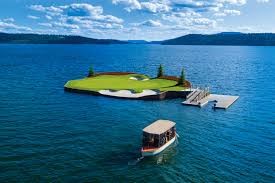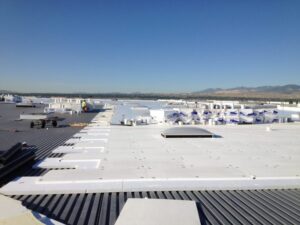A Hole in One: Specialty EPS Applications
Few golfers are fortunate enough to experience a round against a backdrop as jaw dropping as the second largest lake in northern Idaho. Picture this: an electric boat, appropriately dubbed “Putter,” transports players across the pristine blue waters of Lake Coeur d’Alene in Coeur d’Alene, Idaho, to a 6,500 square foot floating green.
 The world’s only floating green, this award-winning 14th hole is an engineering marvel. As one of the course designers Scott Miller explains: “It’s built like a big ship. The entire green complex is comprised of concrete cells that fit together like Legos or Tetris pieces (many bridges in the Pacific Northwest are assembled the same way). Each cell is about 3 ft wide by 3 ft high by 6 ft long. The cells are hollow in the middle, filled with (expanded polystyrene) insulation, which creates buoyancy. And, if the cells crack, they will not take on water.”
The world’s only floating green, this award-winning 14th hole is an engineering marvel. As one of the course designers Scott Miller explains: “It’s built like a big ship. The entire green complex is comprised of concrete cells that fit together like Legos or Tetris pieces (many bridges in the Pacific Northwest are assembled the same way). Each cell is about 3 ft wide by 3 ft high by 6 ft long. The cells are hollow in the middle, filled with (expanded polystyrene) insulation, which creates buoyancy. And, if the cells crack, they will not take on water.”
It might be surprising to some that Miller was referring to the use of expanded polystyrene (EPS) insulation within each concrete cell. The rigid foam’s buoyant nature, proven water-resistance and long-term R-value all lend to the usage of EPS as a flotation solution.
Superior nature of EPS lends to a high-performance flotation solution
Due to its buoyant nature, EPS can be used for a variety of flotation solutions, including rafts, docks, boogie boards and even houseboats. In this case, the 14th hole utilizes a highly engineered version of an EPS buoyancy billet. Due to the extreme weight of the floating structure (2,200 tons), EPS is incorporated as the core of the reinforced concrete cell. In conjunction with concrete, EPS can support substantially more weight than traditional wood flotation devices. And, because the rigid foam is ultra-lightweight and can be custom cut to meet project requirements, installation costs are low.
In addition to being a highly buoyant material, Miller also praised EPS’ water-resistant nature. Its closed cell structure acts as a safeguard, reducing the absorption of moisture into the rigid foam and ultimately protecting the 14th hole structure from detrimental water damage.
EPS’ powerful properties are applicable not only to flotation solutions, as seen at the Coeur d’Alene Resort Golf Course, but also to a range of applications such as bicycle helmets and automobile components. These innovative applications benefit from EPS’ superior ability to absorb impact energy, its ultra-lightweight composition and its ability to meet a myriad of design challenges in a cost-effective manner. Interested in learning more about how EPS serves specialty applications? Reach out to us at www.insulfoam.com/contact-insulfoam/.


